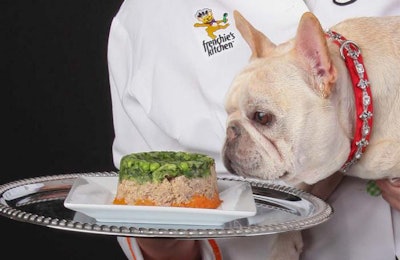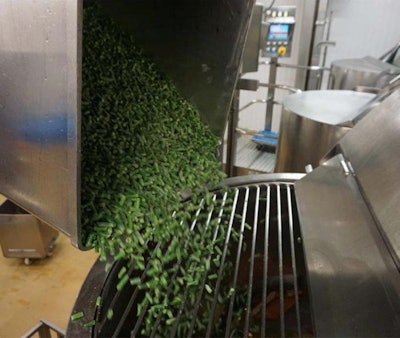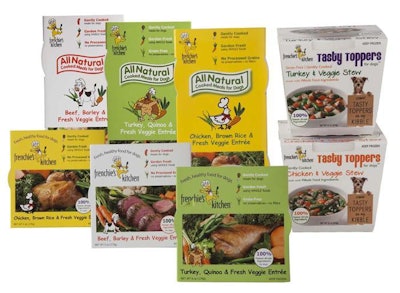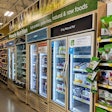
Frenchie’s Kitchen found two keys to consistent growth in the premium dog food market: consumer education and continuing innovation, the company’s founder and president told Petfood Industry. Sara Kuris-Morgan started Frenchie’s with a focus on frozen, “gently cooked” pet food at a time when few other companies sold similar products, she said.
She needed to educate her potential customers about why they should try frozen dog food. Although challenging, being a pioneering brand gave her company first-mover advantages, and Frenchie’s sales grew as more pet owners started worrying about dog and cat food safety.
Tapping into human-grade, clean label and other trends
After the disastrous US pet food recalls of 2007, dog and cat owners increasingly looked for pet foods promoted as containing US Department of Agriculture (USDA)-certified, US-sourced ingredients from human-grade facilities. Soon after the tragedies, Frenchie’s was founded in 2007 to cater to those consumers.
“The recalls were just the beginning of getting the interest of the general public,” said Kuris-Morgan. “All of a sudden it became personal and was an issue. People were now paying attention to what was being put in their dog food and where it comes from.”
Kuris-Morgan intends to continue meeting those consumers’ demands with the most recent additions to the brand: US-made, human-grade chicken and turkey dog food toppers. Along with quality certifications, clean labels are also catching consumers’ eyes by presenting few but familiar ingredients. Frenchie’s reduced the number of syllables in their ingredients by avoiding synthetic vitamins, preservatives and flavors. Instead, the meat, fruit and vegetable ingredients alone provide the nutrients.

Fresh green beans going into the kettle for Tasty Toppers for Dogs. | Courtesy Frenchie's Kitchen
“At Frenchie’s Kitchen, the vitamins and minerals in our products come from the food itself,” Kuris-Morgan said. “For example, carrots are an excellent source of vitamins A and C, calcium, potassium and fiber. Our ingredient deck is clean and simple, easy to understand. There isn’t anything on the ingredient panel that you cannot pronounce, and we are very proud of that.”
Staying on the edge of consumer trends is a key to growth in the pet food industry, she said. Being a trendsetter meant listening to consumer needs and responding to them. She believes pet owners are beginning to understand the importance of what they feed dogs, cats and other pets. Frenchie’s positions its products in the market to satisfy those pet owners’ interests in the ingredients used and nutrition they provide.
Pet food sales growth through consumer education
Speaking of meeting a rising niche in pet food buyer demand, Frenchie’s plans to launch a vegan pet food stew in early 2017. Vegan pet food maintains a place in the market, although it stands in stark contrast to the popularity of grain-free and all-meat pet foods. Veterinarians have cautioned that vegan diets can be difficult to maintain for omnivorous dogs and carnivorous cats. However, Kuris-Morgan pointed out that vegan pet foods may have a role to play for certain dogs.
“This [vegan] stew will benefit dogs that have sensitivities to specific proteins but still want a healthy topper for their kibble,” said Kuris-Morgan. "It is intended to be served on top of kibble to add a boost of natural vitamins and minerals. The dog will receive the required amount of protein from the kibble. We are true believers that dogs are carnivores not vegans."
Educating pet owners about how to properly use vegan pet foods mirrors a main challenge that Frenchie’s has faced since its founding. Being an early adopter of a pet food trend means a pet food company needs to not only innovate in production and distribution, but also in marketing. Most consumers need education before trying an unfamiliar pet food. Informing consumers about new styles of dog food, such as frozen or human-grade, has been central to Frenchie’s success.
“Another key to growth is education,” said Kuris-Morgan. “By educating customers of the benefits of a quality diet for their dogs, they will better understand the distinction of our entrees from the standard dog food products on the retail shelves. … Since we were one of the first, it required doing lots of education and demos to show people what fresh food was all about.”
USA-made, certified ingredient challenges
Even with education, another challenge exists: the conflict between the cost of Frenchie’s ingredients and consumers’ willingness to pay a premium for pet foods made with human-grade ingredients. The raw ingredients are more expensive than those of conventional dog foods, she said. Sourcing only USA-made products adds to the cost, as does testing for certification by USDA.
“Our biggest challenge today is price and margins,” said Kuris-Morgan. “There is nothing cheap about our product, however we get pressure every day to lower our prices to compete with the big pet food manufacturers. ... Unfortunately, this is not possible.”
Selling frozen dog food also presented specific challenges, especially when the segment was new and many pet specialty stores lacked freezers.
“Another big challenge is ‘real estate’ – freezer space in the stores,” she said. “Although more and more stores have freezers, it is sometimes difficult to get placement.”

Frenchie's Kitchen products are made in a USDA-inspected, human-grade facility in Southern California. | Frenchie's Kitchen
Sales growth and giving back
Despite freezer space shortages and costly ingredients, Frenchie’s has grown dramatically since its founding, said Kuris-Morgan. The brand consistently has released new products and updated packaging and labeling.
“Over the past five years, we have experienced a minimum of double-digit sales growth each year,” she said. “As we expand our distribution, we expect to see these numbers grow even more.”
Frenchie’s returns a portion of those profits to the community. The company donates a portion of all proceeds to rescue groups and no-kill shelters. As with their dog foods, Kuris-Morgan believes education is the key to reducing the number of homeless dogs, so Frenchie’s donates to spay/neuter groups.
Just the Facts

Headquarters: San Antonio, Texas, USA
Facilities: California, USA
Officers: Sara Kuris-Morgan, founder/president
Sales: Over the past five years, we have experienced a minimum of double-digit sales growth each year. As we expand our distribution, we expect to see these numbers grow even more.
Brands: Frenchie’s Kitchen TDF (to-drool-for) Entrees & Tasty Toppers for Dogs
Distribution: USA with plans to expand into Canada in 2017
Employees: 12
Website/Social Media: www.frenchieskitchen.com, @frenchieskitchen on Twitter, Frenchie’s Kitchen on Facebook
Read more:
How pet food companies are giving back to pets, people, www.PetfoodIndustry.com/articles/6067

















